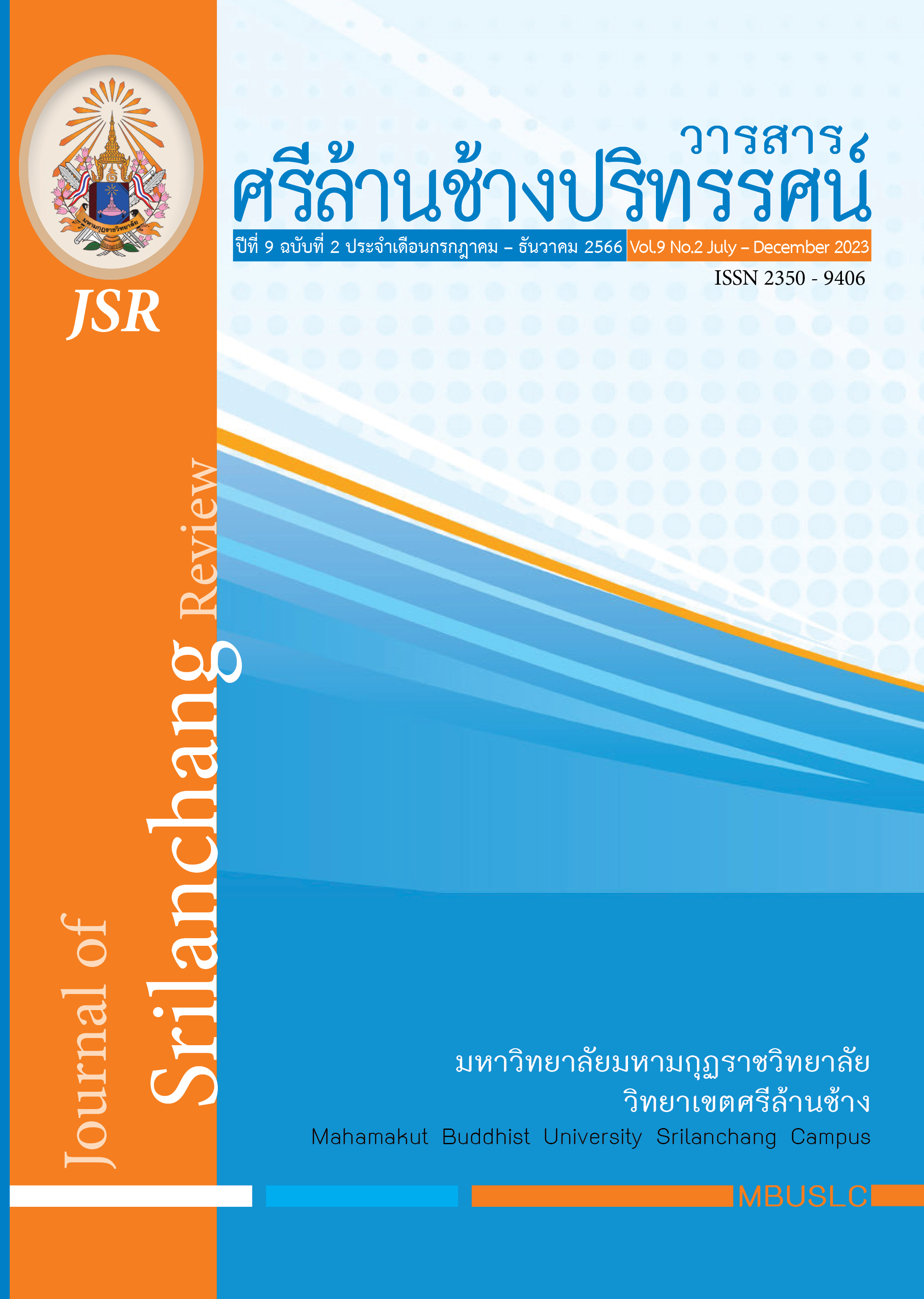GUIDELINES FOR RISK MANAGEMENT OF SCHOOL UNDER LOEI PRIMARY EDUCATIONAL SERVICE AREA OFFICE 2
Main Article Content
Abstract
The purposes of the research were to study current conditions desirable conditions and needs of risk management in school, to study guidelines of risk management in school and, and to assess guidelines of risk management in schools. The study was divided into three phases. The first phase was the study of current conditions, desirable conditions and needs of risk management in schools. The sample consisted of 64 school administrators and 188 teachers, selected by using Krejcie and Morgan table, including the stratified random sampling. The instrument was the rating scale questionnaire. The second phase was the study of school risk management guidelines, comprising two steps; the first step of data collection from three school administrators by the in-depth interview, and the second step of data collection from nine experts by the focus group discussion. The third phase was the assessment of school risk management guidelines by five experts by the questionnaire. The statistics used for data analysis consisted of frequency distribution, percentage, arithmetic mean, standard deviation and the modified priority needs index (PNIM). The descriptive analytics was used for the qualitative data analysis. The results of the research revealed that the current condition of risk management in the schools under Loei Primary Educational Service Area Office 2 was totally found at the high level (x̅ = 3.78, S.D. = 0.62). The desirable condition was totally found at the highest level (x̅ = 4.84, S.D. = 0.37) and the modified priority needs index in the descending order were 1. Risk Identification (PNImodified = 0.293), 2. Risk Management (PNImodified = 0.285), and 3. Risk Assessment (PNImodified = 0.280). The other finding disclosed that the guidelines on school risk management comprised four compositions. The first risk identification consisted of three methods, four activities/projects and four practices. The second of risk management consisted of three methods, four activities/projects and four practices. The thire risk assessment consisted of three methods, four activities/projects and four practices. The fourth risk monitoring and evaluation consisted of three methods, four activities/projects and four practices. Another finding was the evaluation of school risk management guidelines by five experts. The overall result was at the highest level (x̅ = 4.92, S.D. = 0.19). Individually considered in the descending order, they were the utility (x̅ = 4.99, S.D. = 0.03), the feasibility (x̅ = 4.89, S.D. = 0.25), and the propriety (x̅ = 4.87, S.D. = 0.30), respectively.
Article Details

This work is licensed under a Creative Commons Attribution-NonCommercial-NoDerivatives 4.0 International License.
บทความที่ได้รับการพิจารณาจากคณะกรรมการผู้ทรงคุณวุฒิและเผยแผ่ในวารสารฉบับนี้ เป็นทัศนคติและข้อคิดเห็นส่วนบุคคลของผู้เขียนแต่ละท่าน ไม่ถือว่าเป็นทัศนะคติและความรับผิดชอบ
ของบรรณาธิการ
บทความ ข้อมูล เนื้อหา รูปภาพ ฯลฯ ที่ได้รับการตีพิมพ์ในวารสารศรีล้านช้างปริทรรศน์ ถือเป็นลิขสิทธิ์ของวารสารศรีล้านช้างปริทรรศน์ หากบุคคลหรือหน่วยงานใดต้องการนำทั้งหมดหรือส่วนหนึ่งส่วนใดไปเผยแพร่ต่อหรือเพื่อกระทำการใด ๆ จะต้องได้รับอนุญาตเป็นลายลักอักษรจากวารสารศรีล้านช้างปริทรรศน์ ก่อนเท่านั้น
References
กรรณิการ์ ศิริรัตน์. (2563). การบริหารความเสี่ยงของโรงเรียนเอกชน จังหวัดน่าน สังกัดสำนักงานศึกษาธิการจังหวัดน่าน. วิทยานิพนธ์ กศ.ม. (การบริหารการศึกษา). พะเยา: บัณฑิตวิทยาลัย มหาวิทยาลัยพะเยา.
ครองยุทธ นบนอบ. (2563). ปัจจัยที่ส่งผลต่อความสำเร็จการบริหารความเสี่ยงในสถานศึกษาสังกัดสำนักงานเขตพื้นที่การศึกษาประถมศึกษาสมุทรปราการ เขต 2. วิทยานิพนธ์ ค.ม. (การบริหารการศึกษา). ฉะเชิงเทรา: บัณฑิตวิทยาลัย มหาวิทยาลัยราชภัฏราชนครินทร์.
จรัญ พะโยม. (2556). การพัฒนากลยุทธ์การบริหารความเสี่ยงในสถนศึกษาขั้นพื้นฐานสังกัดสำนักงานเขตพื้นที่การศึกษาประถมศึกษากำแพงเพชร เขต 1 และเขต 2. วิทยานิพนธ์ ปร.ด. (ยุทธศาสตร์การบริหารและการพัฒนา). กำแพงเพชร: บัณฑิตวิทยาลัย มหาวิทยาลัยราชภัฏกำแพงเพชร.
ชุติมา ชูชั่ง. (2560). ความคิดเห็นของครูที่มีต่อการบริหารความเสี่ยงของผู้บริหารสถานศึกษา สังกัดสำนักงานเขตพื้นที่การศึกษามัธยมศึกษา เขต 3. ออนไลน์. สืบค้นเมื่อ 25 สิงหาคม 2565. แหล่งสืบค้น: http://www.edu-journal.ru.ac.th/index.php/abstractData/viewIndex/1126.ru.
ณัฐชา กลิ้งทะเล. (2561). การบริหารความเสี่ยงของโรงเรียนในกลุ่มตากสิน สังกัดสำนักงานเขตพื้นที่การศึกษาประถมศึกษาระยอง เขต 1. วิทยานิพนธ์ ศษ.ม. (การบริหารการศึกษา). ชลบุรี: มหาวิทยาลัยบูรพา.
ปนัดดา แก้วศรี. (2560). แนวทางการบริหารความเสี่ยงด้านการเสริมสร้างประสิทธิภาพในการปฏิบัติราชการในโรงเรียนสังกัดสำนักงานเขตพื้นที่การศึกษาประถมศึกษาปทุมธานี. วิทยานิพนธ์ ศษ.ม. (การบริหารการศึกษา). ปทุมธานี: บัณฑิตวิทยาลัย มหาวิทยาลัยเทคโนโลยีราชมงคลธัญบุรี.
ปรตี ประทุมสุวรรณ์. (2559). กลยุทธ์การบริหารความเสี่ยงของโรงเรียนมัธยมศึกษาตามแนวคิด การพัฒนาความเป็นพลเมืองโลก. วิทยานิพนธ์ ปร.ด. (บริหารการศึกษา). กรุงเทพฯ: บัณฑิตวิทยาลัย จุฬาลงกรณ์มหาวิทยาลัย.
ประณต มีสอน. (2560). รูปแบบการบริหารความเสี่ยงของมหาวิทยาลัยราชภัฏในเขตกรุงเทพมหานคร. วิทยานิพนธ์ ปร.ด. (การบริหารการศึกษา). กรุงเทพฯ: มหาวิทยาลัยนอร์ทกรุงเทพ.
ปรีชา มณฑาทิพย์. (2560). กลยุทธ์การบริหารจัดการความเสี่ยงทางการศึกษาของโรงเรียนประถมศึกษาขนาดเล็ก สังกัดสำนักงานเขตพื้นที่การศึกษาประถมศึกษานครราชสีมา. วิทยานิพนธ์ปรัชญาดุษฎีบัณฑิต สาขาวิชาภาวะผู้นำทางบริหารการศึกษา มหาวิทยาลัยราชภัฏนครราชสีมา.
พอรุ้ง แสงนวล. (2563). การบริหารความเสี่ยงกับประสิทธิผลของโรงเรียนสังกัดสำนักงานเขตพื้นที่การศึกษามัธยมศึกษา เขต 1. วิทยานิพนธ์ ศษ.ม. (การบริหารการศึกษา). กรุงเทพฯ: บัณฑิตวิทยาลัย มหาวิทยาลัยศิลปากร
ราตรี เลิศหว้าทอง. (2561). การพัฒนารูปแบบการบริหารจัดการความเสี่ยงงานวิชาการของสถานศึกษาสังกัดองค์การบริหารส่วนจังหวัดโดยประยุกต์ใช้แนวคิด SIPOC MODEL. วิทยานิพนธ์ กศ.ด. (การบริหารและพัฒนาการศึกษา). มหาสารคาม: บัณฑิตวิทยาลัย มหาวิทยาลัยมหาสารคาม.
สำนักงานเขตพื้นที่การศึกษาประถมศึกษาเลย เขต 2. (2564). รายงานการสังเคราะห์การประเมินตนเองของสถานศึกษา สำนักงานเขตพื้นที่การศึกษาประถมศึกษาเลย เขต 2. ออนไลน์. สืบค้นเมื่อ 25 สิงหาคม 2565. แหล่งสืบค้น https://www.loei2.go.th/.
เอกลักษณ์ ป้องกัน. (2560). การบริหารความเสี่ยงของผู้บริหารสถานศึกษา สังกัดสำนักงานเขตพื้นที่การศึกษาประถมศึกษาอุบลราชธานี เขต 3. วิทยานิพนธ์ ค.ม. (การบริหารการศึกษา). อุบลราชธานี: บัณฑิตวิทยาลัย มหาวิทยาลัยราชภัฏอุบลราชธานี
Cronbach, Lee J. (1990). Essentials of Psychological Testing. New York: McGraw-Hill.
Krejcie, R.V., & Morgan, D.W. (1970). Determining Sample Size for Research Activities. Educational and Psychological Measurement, 30(3), 607 – 610.
Likert, R.A. (1961, May). Technique for the Measurement of Attitudes. Arch Psychological, 25(140), 1 – 55.


